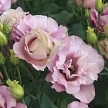
Eustoma
Purple, white and pink corollas
| Latin name | Eustoma |
| Alternative name | Lisianthus |
| Homeland | North America |
| Family | Gentianaceae |
| Cultivation | complex |
| Location | ambient light |
| Temperature | optimal 18-22 °C, minimum 7°C |
| Watering | regular |
| Flowering time | outdoors in summer, at home not from the time of year |
| Height | up to 90 cm |
| Transplanting | not performed |
| Appearance maintenance | remove wilted flowers |
Only 2 species belong to the genus Eustoma, of which only one is grown everywhere - Eustoma grandiflorum, commonly called Lisianthus russilianus. This plant is attractive both as a cut crop and as a potted one, 90 cm high, herbaceous and perennial, but grown as an annual. It is characterized by green lanceolate leaves and large funnel-shaped flowers of blue, purple, pink or white color.
Only 2 species belong to the genus Eustoma, of which only one is grown everywhere - Eustoma grandiflorum, commonly called Lisianthus russilianus. This plant is attractive both as a cut crop and as a potted one, 90 cm high, herbaceous and perennial, but grown as an annual. It is characterized by green lanceolate leaves and large funnel-shaped flowers of blue, purple, pink or white color.
Cultivation
Eustoma is grown both at home and in the fresh air in the form of a potted plant or in the open ground. Young specimens are planted in pots with a diameter of 10-12 cm in groups of three specimens. When growing both in a pot and in the open ground, a mixture consisting of turf land (50%), peat (25%) and sand (25%) is used with the addition of a full mineral long - acting fertilizer with microelements (primarily iron) and a reduced phosphorus content - at the rate of 15-20 g per bucket of soil. Before the beginning of flowering, a liquid complex fertilizer is added to the water for irrigation in in the amount of 10-20 ml per bucket. To reduce the size of the plant, it is recommended to pinch it. Eustoma is also used as a beautiful flowering plant for cutting. Flowers are obtained 2-3 weeks after planting in a permanent place in the garden. In this case, the plant is formed by a lush bush and is characterized by abundant flowering.
Eustoma is grown both at home and in the fresh air in the form of a potted plant or in the open ground. Young specimens are planted in pots with a diameter of 10-12 cm in groups of three specimens. When growing both in a pot and in the open ground, a mixture consisting of turf land (50%), peat (25%) and sand (25%) is used with the addition of a full mineral long - acting fertilizer with microelements (primarily iron) and a reduced phosphorus content - at the rate of 15-20 g per bucket of soil. Before the beginning of flowering, a liquid complex fertilizer is added to the water for irrigation in in the amount of 10-20 ml per bucket.
To reduce the size of the plant, it is recommended to pinch it. Eustoma is also used as a beautiful flowering plant for cutting. Flowers are obtained 2-3 weeks after planting in a permanent place in the garden. In this case, the plant is formed by a lush bush and is characterized by abundant flowering.
Location
Eustoma requires a bright, protected place from direct sunlight.
Temperature
During the growing season, the optimal temperature is 18-22 °C. In winter, depending on the illumination of 10-15 °C, colder wintering is also possible.
Watering
During the entire growing season, watering should be regular; it is not recommended to over-dry the soil.
Care
It is necessary to remove withered flowers, as well as yellowed and damaged leaves.
Reproduction
In order for the plants to bloom in the summer, they are sown at the end of winter in boxes that are kept in a cool room. After germination, the seedlings are transplanted into cellular containers or cups. Eustoma grown at home can also bloom at other times. Flowers appear in 4-5 months. Cuttings about 2 cm long take root at a soil temperature of about 20 °C. Seeds germinate at 20-25 °C.
Diseases
Eustoma is susceptible to Lievellula taurico, which causes a whitish mold to appear on the plant. They get rid of it by carrying out weekly treatment with triforin and benzimidazole fungicides. In summer, whiteflies and thrips can choose the plant. In this case, treatment with insecticides based on deltamethrin or diazinone is necessary.
Acquisition
Eustoma seeds and seedlings are purchased in well-stocked flower shops and gardening centers. Choose plants with a lot of buds - so that you can enjoy their blooming for a long time - and with green glossy leaves without yellowing.